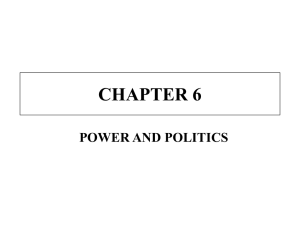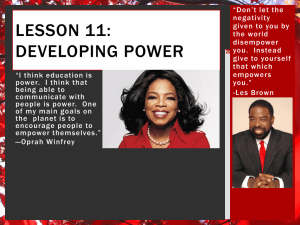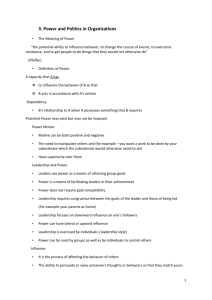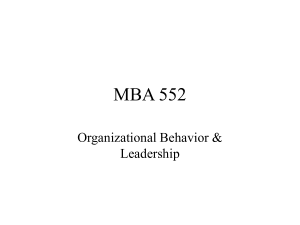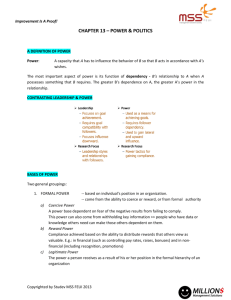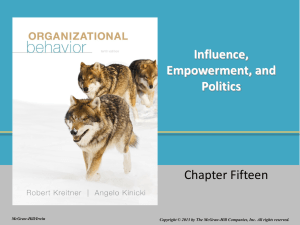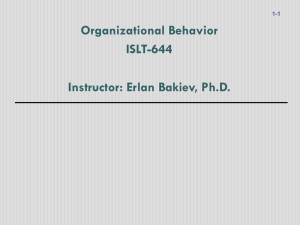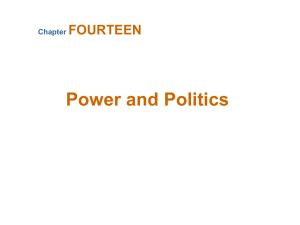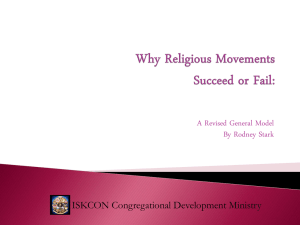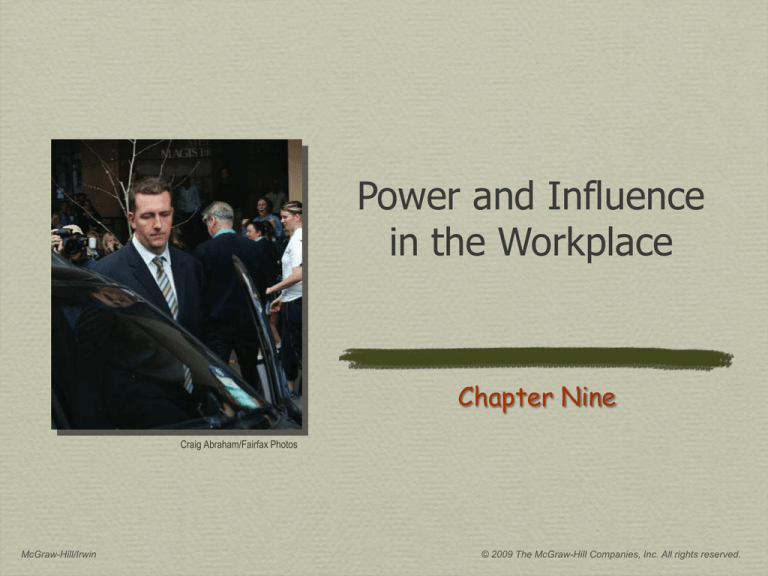
Power and Influence
in the Workplace
Chapter Nine
Craig Abraham/Fairfax Photos
McGraw-Hill/Irwin
© 2009 The McGraw-Hill Companies, Inc. All rights reserved.
Power, Influence & Politics at NAB
National Australia Bank (NAB)
rogue trader Luke Duffy and
his colleagues created losses of
$350 million, thanks in part of
Duffy’s power and influence
tactics.
Craig Abraham/Fairfax Photos
9-2
The Meaning of Power
Power is the capacity of a
person, team, or organization
to influence others.
Craig Abraham/Fairfax Photos
Potential, not practice
People have power they don’t
use -- may not know they
possess
Power requires one person’s
perception of dependence on
another person
9-3
Power and Dependence
Person B’s
countervailing
power over
Person A
Person A
Person A’s control
of resource
valued by person
B
Resource
desired by
person B
Person B
Person A’s
power over
Person B
9-4
Model of Power in Organizations
Sources
of Power
Legitimate
Reward
Coercive
Expert
Referent
Power
over others
Contingencies
of Power
9-5
Sources of Power
Legitimate
Agreement that people in certain
roles can request certain
behaviors of others
Based on job descriptions and
mutual agreement from those
expected to abide by this
authority
Legitimate power range (zone of
indifference) is higher in high
power distance cultures
9-6
Sources of Power
Legitimate
Reward
Ability to control the allocation
of rewards valued by others and
to remove negative sanctions
Operates upward as well as
downward
9-7
Sources of Power
Legitimate
Reward
Coercive
Ability to apply punishment
Exists upward as well as
downward
Peer pressure is a form of
coercive power
9-8
Sources of Power
Legitimate
Reward
Coercive
Expert
Individual’s or work unit’s
capacity to influence others by
possessing knowledge or skills
that they value
Employees gaining expert power
over companies in knowledge
economy
9-9
Sources of Power
Legitimate
Reward
Coercive
Expert
Referent
Occurs when others identify with,
like, or otherwise respect the
person
Associated with charismatic
leadership
9-10
Information and Power
Control over information flow
Based on legitimate power
Relates to formal communication network
Coping with uncertainty
Those who know how to cope with organizational
uncertainties gain power
—
—
—
Prevention
Forecasting
Absorption
9-11
Contingencies of Power
Sources
of Power
Power
over others
Contingencies
of Power
Substitutability
Centrality
Discretion
Visibility
9-12
Increasing Nonsubstitutability
Increase control over the resource
Medicine -- exclusive right to perform medical
procedures
Labor unions -- control over skilled labor
Specialists -- exclusive knowledge how to operate or
repair equipment
Differentiate resource from others
Services provided by consulting firms
9-13
Centrality
Degree and nature of interdependence between
powerholder and others
Centrality is a function of:
How many others are affected by you
How quickly others are affected by you
9-14
Discretion and Visibility
Discretion
The freedom to exercise judgment
Rules limit discretion, limit power
Also a perception managers with internal locus of control
act like they have discretion
Visibility
Symbols communicate your power source(s)
—
—
Educational diplomas
Clothing etc (stethoscope around neck)
Salience
—
Location where others are more aware of your presence
9-15
Social Networking and Power
Cultivating social relationships with others to
accomplish one’s goals
Increases power through:
social capital -- durable network that connects people to
others with valuable resources
referent power -- people tend to identify more with
partners within their own networks
visibility and centrality contingencies
9-16
Influencing Others
Power and Influence
in the Workplace
McGraw-Hill/Irwin
© 2009 The McGraw-Hill Companies, Inc. All rights reserved.
Influencing Others
Influence is any behavior that attempts to alter
someone’s attitudes or behavior
Applies one or more power bases
Process through which people achieve organizational
objectives
Operates up, down, and across the organizational
hierarchy
9-18
Types of Influence
Silent
Authority
• Following requests without overt influence
• Based on legitimate power, role modeling
• Common in high power distance cultures
Assertiveness • Actively applying legitimate and coercive
power (“vocal authority”)
• Reminding, confronting, checking,
threatening
more
9-19
Types of Influence
(con’t)
Information
Control
• Manipulating others’ access to information
• Withholding, filtering, re-arranging
information
Coalition
Formation
• Group forms to gain more power than
individuals alone
1. Pools resources/power
2. Legitimizes the issue
3. Power through social identity
more
9-20
Types of Influence
Upward
Appeal
(con’t)
• Appealing to higher authority
• Includes appealing to firm’s goals
• Alliance or perceived alliance with higher
status person
Ingratiation/
Impress. Mgt.
• Ingratiation
• Impression Management
more
9-21
Types of Influence
Persuasion
Exchange
(con’t)
• Logic, facts, emotional appeals
• Depends on persuader, message content,
message medium, audience
• Promising or reminding of past benefits in
exchange for compliance
• Includes negotiation and networking
9-22
Consequences of Influence Tactics
Hard Influence
Tactics
Soft Influence
Tactics
Silent authority
Persuasion
Upward appeal
Coalition formation
Ingratiation &
impression mgt
Information control
Exchange
Assertiveness
Resistance
Compliance
Commitment
9-23
Steve Jobs’ Reality Distortion Field
Steve Jobs, CEO of Apple
Computer and Pixar Animation
Studios, is famous for
influencing people through his
persuasiveness, which draws
them into his “reality distortion
field.”
9-24
Contingencies of Influence Tactics
“Soft” tactics generally more acceptable
than “hard” tactics
Appropriate influence tactic depends
on:
Organizational position
Influencer’s power base
Cultural values and expectations
9-25
Organizational
Politics
Power and Influence
in the Workplace
McGraw-Hill/Irwin
© 2009 The McGraw-Hill Companies, Inc. All rights reserved.
Organizational Politics
Behaviors that others perceive as selfserving tactics for personal gain at the
expense of other people and possibly
the organization.
9-27
Conditions for Organizational Politics
Tolerance of
Politics
Scarce
Resources
Conditions
Supporting
Organizational
Politics
Organizational
Change
Complex and
Ambiguous
Decisions
9-28
Minimizing Political Behavior
Introduce clear rules for scarce resources
Effective organizational change practices
Suppress norms that support or tolerate selfserving behavior
Leaders role model organizational citizenship
Give employees more control over their own work
Keep employees informed
9-29
Power and Influence
in the Workplace
Chapter Nine
Craig Abraham/Fairfax Photos
McGraw-Hill/Irwin
© 2009 The McGraw-Hill Companies, Inc. All rights reserved.

